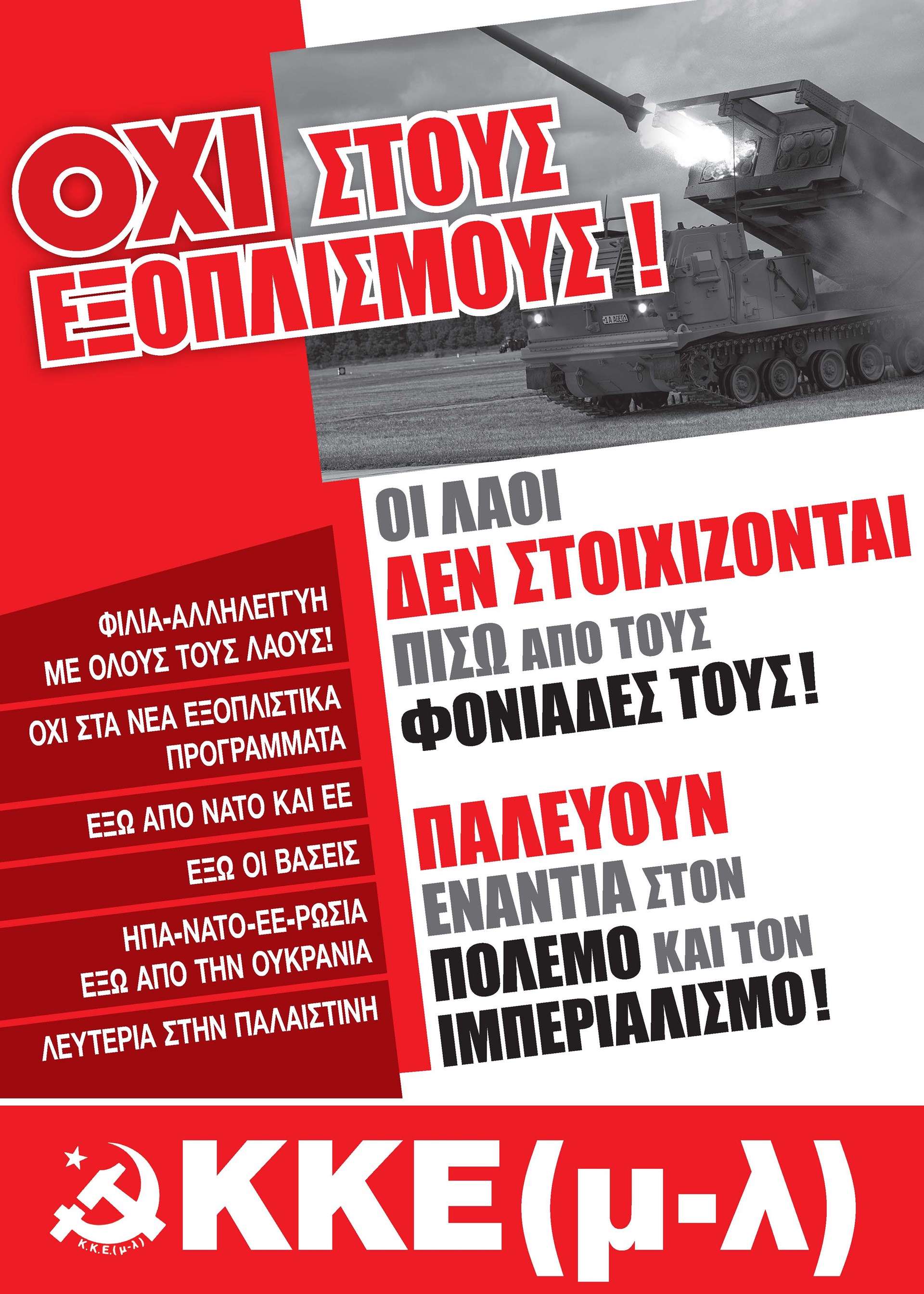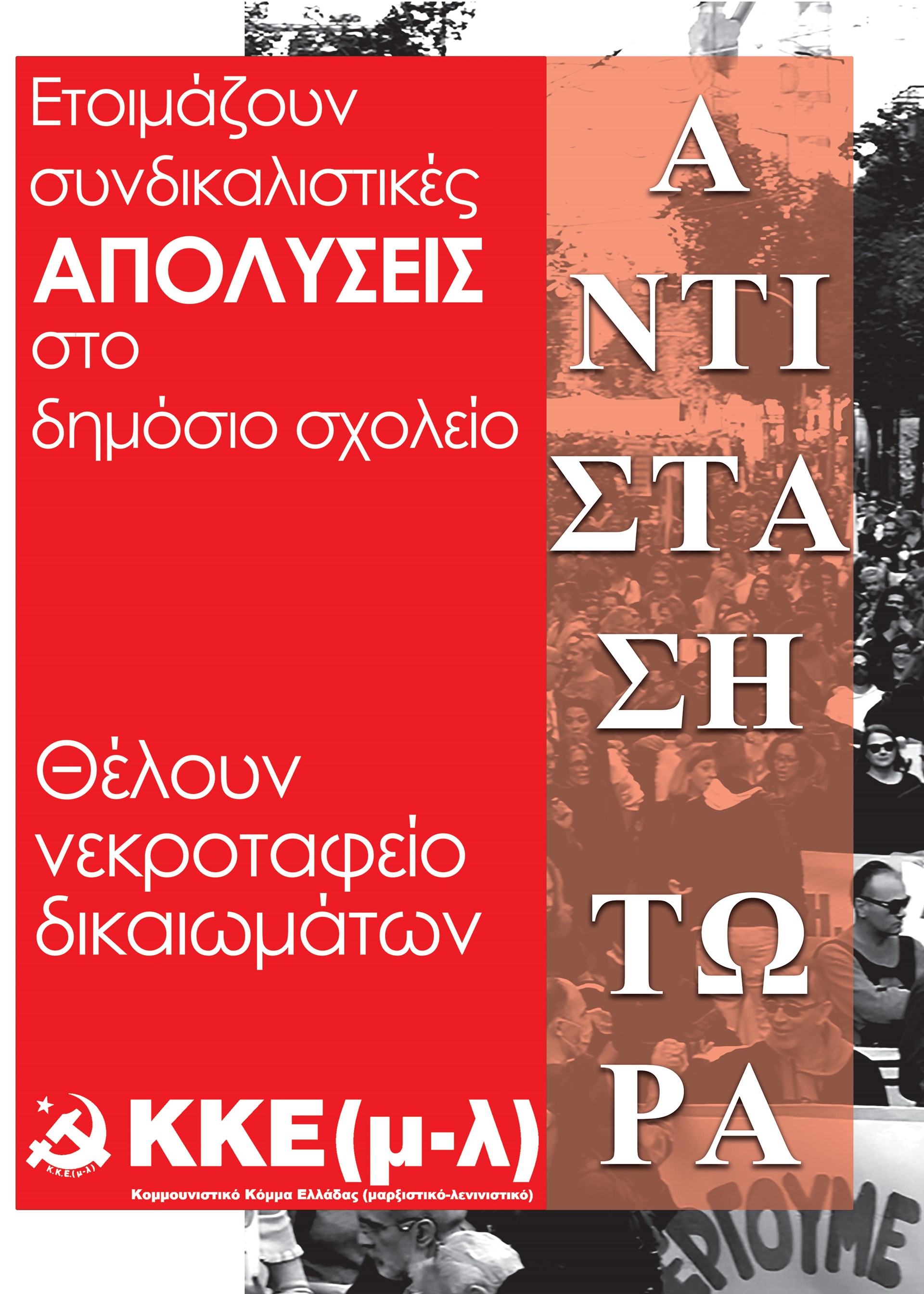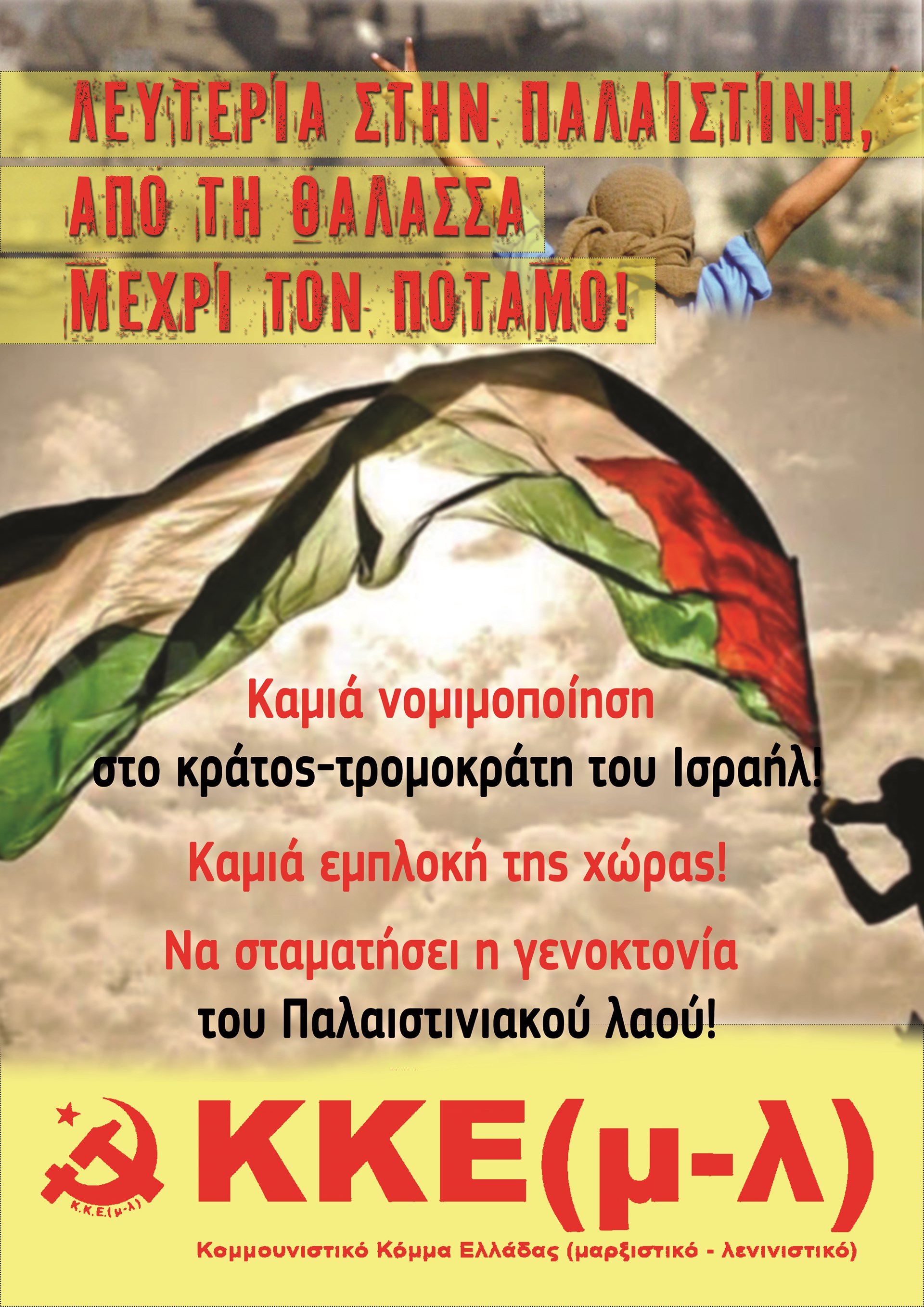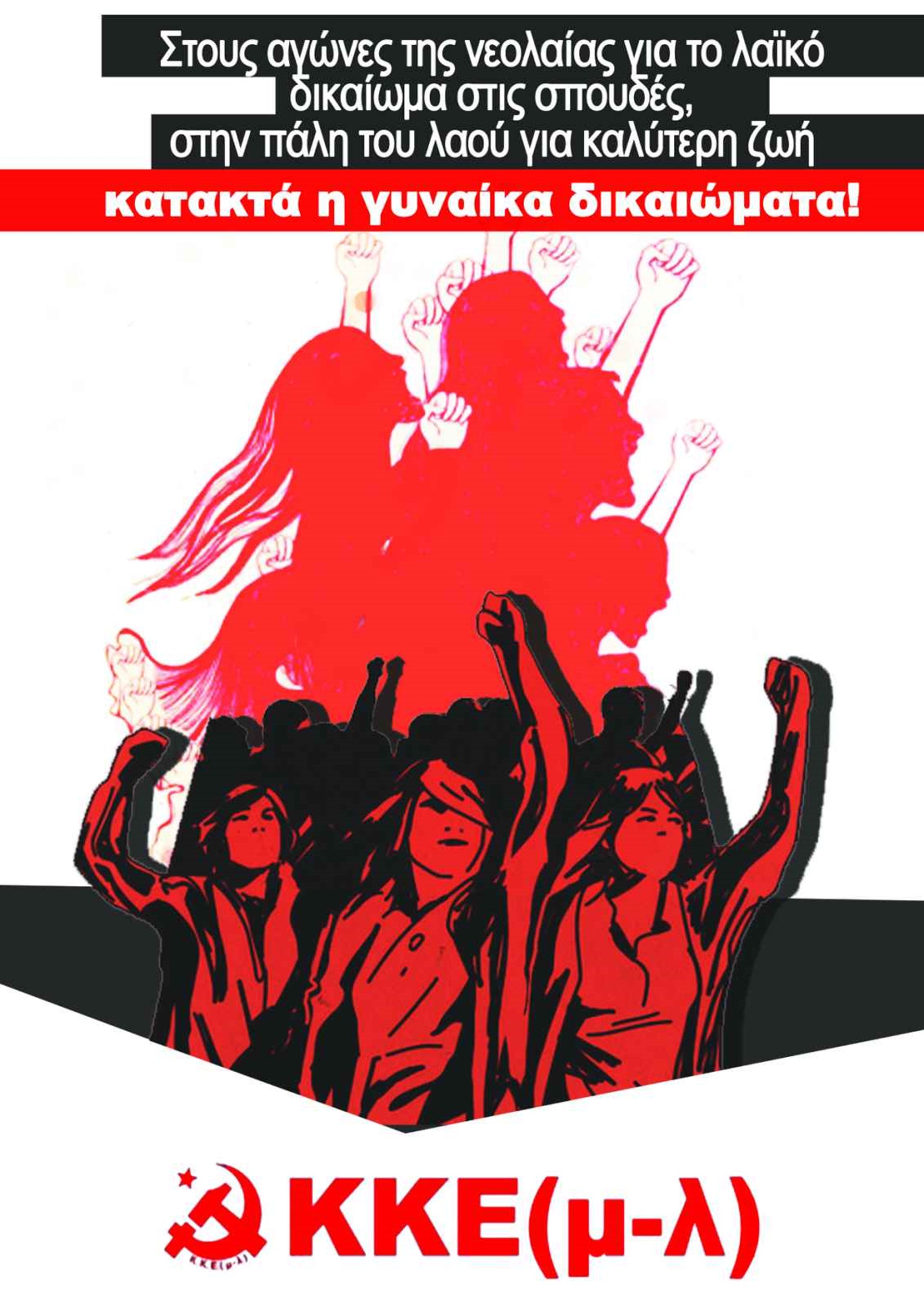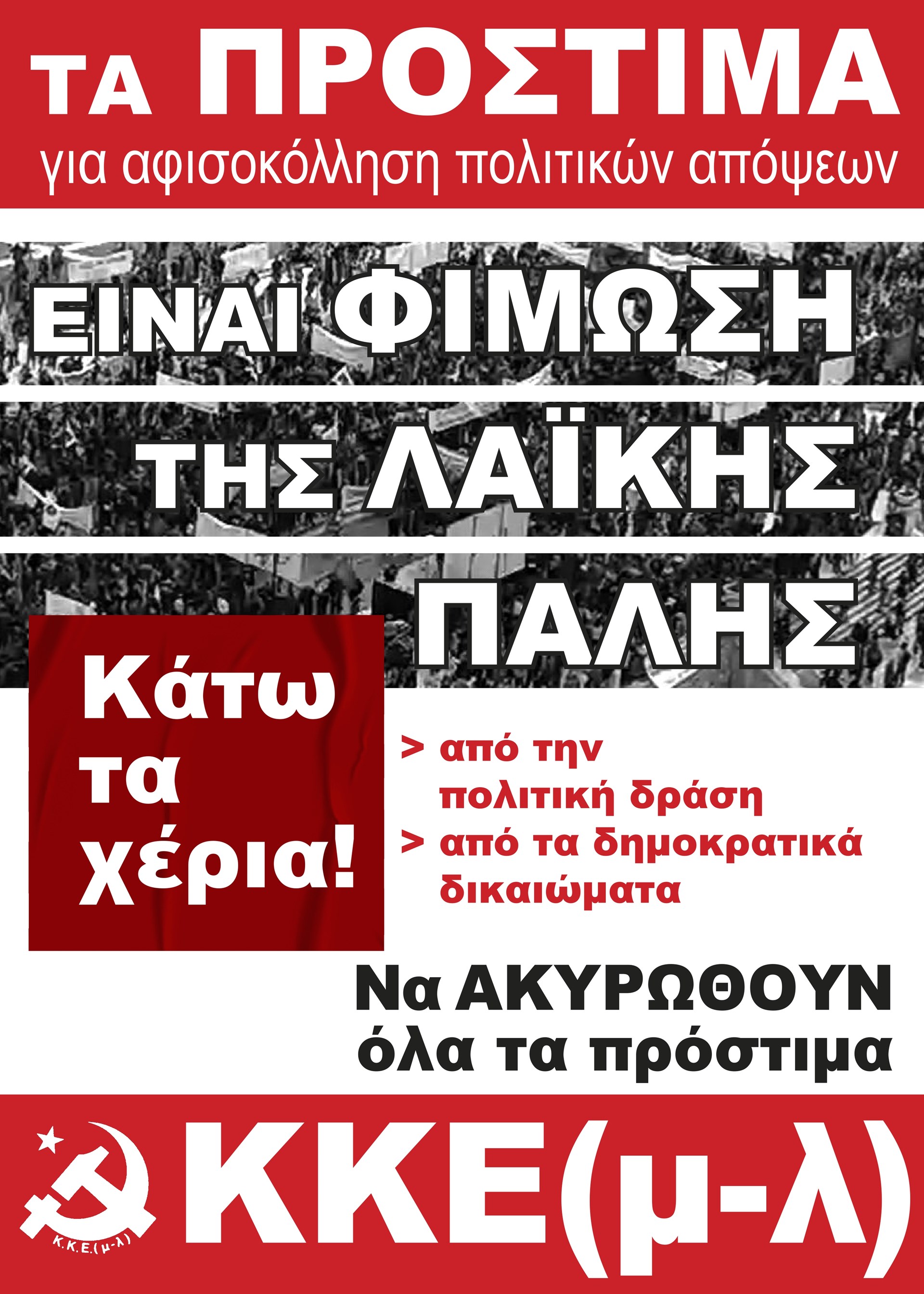Presentation of CPG(m-l) in the International Meeting that took place in Athens on 4 and 5 of November.
Topic of Discussion:
October revolution: Imperialist war – weakest chain link – social alliances -vanguard of the working class – socialist construction. Questions and answers about the October revolution that shook the world
Not all revolutionary situations give birth to revolutions. Neither the rising of the common people nor the crisis of the elite will cause the overthrowing. The objective changes must meet on with the subjective, and the revolutionary class must have the ability to take on action, to guide and to be as powerful as it needs to be to crush the old government, that, as Lenin said, “not even in times of crisis will not fall unless overthrown”.
The 1st Imperialist World War combined the three contradictions (capital-labor, contradictions between imperialists and imperialism-peoples) and accelerated the struggle of the Russian proletariat. In 1917, while Russia was in a general crisis that the provisional government of Kerensky was unable to manage, the workers drive away the management of the enterprises and demand that power passes to the soviets. The peasants are disappointed by the SR party and do not apply the farming program. They defy the landlords, trespass their land, attack their villas and rise against them. The Bolsheviks guide the sailors and the soldiers refuse to fight in the front and driving the reactionary officers away, electing new ones in their place. The objective situation thus creates pre-revolutionary conditions. The correct party line and the determination of the Bolsheviks and the continuous confidence of the masses in them creates the subjective conditions. The power of the soviets of workers, peasants and soldiers is born from the will for a better life and stems from the Aurora guns and the weapons of the Red Guard, which invades the winter palace. The revolution is a reality, the ice has been broken, the road is open, the way has been shown.
The dominance of the monopolies in the dependent countries and of the imperialists over the spheres of influence, the anisometry in the development of the capitalist countries and the bloody competition on recasting of the world are traits of the new era of imperialism described by Lenin. Imperialist wars are the only means for recasting the world. The inevitability of war, however, in conditions of imperialism creates the objective conditions of the coalition of the proletarian forces, creates insurrectional and revolutionary upheavals and imperialism becomes the eve of the socialist revolution. But nothing in life and class struggle, which does not stop, works in automation, nothing is programmed or predetermined. As mentioned above, the revolutionary conditions alone, without the revolutionary bearer, without the vanguard and, of course, without the working masses formed and motivated, do not mean revolution. If the 1st World War and the ongoing crisis of Russian capitalism brought the masses into turmoil and insurrectional situations, the Bolsheviks” guidance, their militancy, their political line, materialized it.
Even within the Bolsheviks there were members who were palming. Trotsky’s views that the revolution «will not stand alone», the situation that the working class “will receive”, the conflict with the peasantry in the retarded Russia, and the that these will be solved only on an international scale with the «global revolution» are on record. Also recorded is Bukharin’s view of deliberate loss of Soviet power for the «interest of the world revolution». It is old and well-known his perception that the only main prerequisite for the revolution is the developed economic situation of each country and that the revolution will be successful only if there are mature objective conditions of development and developed industry from the capitalist system. Perceptions that view the revolution as an exclusive result of the internal development of a given country and not in connection with the development of the contradictions of the global imperialist system. Views that negate the fact that this situation leads to the corresponding weakening of the imperialist front and that this weakening creates favorable conditions for the victory of socialism in a single country. All the above thought that the victory of the revolution is impossible in just one country, believing that in order to win against the bourgeoisie, the proletariat of the most -if not all- the developed countries must be brought together. The October of 1917 was the most enormous defeat of these perceptions: the Russian working class allied with the millions of ruined peasants and broke the chain of the world imperialist front into Russia’s weak link, which -unfortunately for the supporters of Trotskyism- did not have as much «developed capitalism» as they would want.
Supporters of the failure of the Second International claimed that from the bourgeois revolution of 1905 to the socialist one there is an abyss, an almost insurmountable barrier, great walls that do not allow the working class and its allies to claim power, because capitalism «had to develop first», in order for the working class to receive fertile ground. Another cover-up of their counter-revolutionary intentions… History proved them tremendously wrong. The course of the Bolsheviks in 1917 from February and the bourgeois revolution, in the April Theses, October and the seize of power proves that the Bolsheviks succeeded in gaining serious support from the Russian people and, allied with the peasantry, carried the overturning to the end. The contemporary apologists of these theories discover new stages, consider imperialism obsolete and are enthusiast to the capitalist development of the productive forces, in order to extinguish the revolution today in a more «modern» way. They can see globalisation but shut their eyes in front of the contradictions of the powerful of this world, they think that the nation-states are abolishing themselves and turn away from the all-growing exploitation of the dependent countries. They deny the need of struggle for independence and socialism in our country on this day, just like in other countries too.
These concepts are not new at all, instead old and defeated, break out at various moments of class struggle and set in to the movements to disorient and confuse. The theory of «spontaneous» is not new at all either; in an opportunistic way it calls for submission to the spontaneous activity of the labor movement, while in reality it denies that the working class is the vanguard and that it has to prioritize its activity. This theory was presented in the First International and was fiercely fought by Marx and Engels, who draw the conclusion from the experience of the Paris Commune that the working class should be organized at a higher level. Instead, Bakunin and his supporters believed that the theory of «spontaneous» was confirmed. This reappeared in Russia in 1905. Then its followers stubbornly refused the necessity of having an independent labor party with political activity, hiding behind the mass movement and the trade unions, in order to subdue the movement to the liberal -at the time- bourgeoisie. They were standing an obstacle to the communists” attempt to organize and set up the class and the masses at a political level. They limited the working class to the soviets and the existing structures by addressing the issue on the organizational level alone, by denying the guiding role of the party and the working class and the fact that the correlations formed at all levels depend on the political formation of the working class.
The modern denial of revolutionary politics and submission to self-action, which appeared in the squares in our country and internationally, expresses the middle layers of society, which are compressed by the crisis, and denies the existence of any organized action. From Wall Street to Gezi and from Syntagma to Puerta Del Sol, the movements of squares are extinguished because the left and communist direction is unable to guide rage and indignation. The anxiousness of the petty-bourgeois and bourgeois forces also takes on an ideological mantle. Middle layers of society and anyone on a payroll are generally named proletarians, the working class is overflowing, and then the vanguard in society appears to be a mess of social classes with different relationships to the productive process and different interests. The vanguard of the working class was never a numerical matter, but always a political one. The connection of the working class to production is the critical point, alongside with its ability to take control of production and manage it. Also, the matter of power of the working class, we dare say that isn’t numerical at all. Besides, the bourgeoisie is nothing but a handful of capitalists, a weak social minority and yet have the power. This is because they politically dominate the production and all aspects of the superstructure. Stalin said on the weak link in “The Foundations of Leninism”: «The chain of the imperialist front should generally break where the links of the chain are weaker and not obligatory where capitalism is more developed where proletarians are either this percent of the population or that, the same for peasants, and so on. That is why the statistical calculations on the percentage of the proletariat in the composition of the population in each country miss the exclusive importance on the solution of the issue of the proletarian revolution…»
The formation of today’s working class is not an abstract process that starts from scratch. The capital and imperialism can try to erase the collective memory and the achievements of the working class, but its vanguard insists on the communist direction. They still insist today to organize and fight, even when the flags of the movement have been crumpled by the reformists and crashed by the system. The overriding issue of the formation of the working class as a class for it’s own rights has never been and is not until today a linear and predetermined process. The class struggle advances and with it the confrontations of the proletariat and the peoples evolve. Building the revolutionary subject, the vanguard party, can not be a metaphysical process. It is a dialectical process, in which, as long as the class is formed, the party will be formed and vice versa. In this phase, in which in our country the main and basic contradictions emerge and intertwine, the working class will be mainly established in the clash against capital, and will lead through its confrontation with imperialism. The formation of the vanguard cannot be done in another basis. For us, CPG(m-l), the communist movement could play a leading role only when it left aside the logic of reproduction and copying revolutionary models and leaned over the actual data.
In this sense, the guidance of the Bolsheviks was able to lead only after the concrete analysis of the concrete situation in Russian society, the complexity of the contradictions and their own political and organizational capacity. The slogan «Peace, Land, Bread» was the specialization of the political situation in a specific period of time. The alliance of workers and peasants and the proletariat’s leadership inside it emerged again from the proper class analysis of the Russian society at that time. Based on this, Lenin confronted Trotsky and the followers of the theory of «permanent revolution», believing that the revolutionary potential of the peasantry for the elimination of the Tsarist regime and the transition to the proletarian revolution must be exhausted. On the other hand, the followers of the «permanent revolution» did not understand this need and underestimated the power of the Russian proletariat, as a leading social force, to bring the peasantry on its side. It is not by accident that this is the period when Trotsky’s views on the militarization of labor and the working class itself appeared and had some bases. This is the period of the passage from War Communism to the NEP. At that time, trying to answer the actual problem of de-industrialization and influenced by the urgent measures of the War Communism, he concluded that the dictatorship of the proletariat was also exploiting the peasantry. On the other hand, the views of Kollontai, Shlyapnikov and the Labor Opposition for the collectives-trade unions that should lead production, which is at the other end of Trotsky’s view of nationalizing the trade unions, reach the point to negate the socialist state and the party as guiding forces, which undertake the task to plan production. Fortunately, however, the character of the Bolshevik party and its leading role had been forged by the class struggle itself and had been established by the Soviet people. Thus, it must be understood that the Communist Organization or the Party is a superior political concentration of class consciousness, which must be tested in the field of class contradictions and the struggle that is taking place over these contradictions. It does not exist for itself and the measure of its success is not its own development but the rights and achievements of the workers, the development and organization of the working people’s movement that the times require.
The victory of Socialism in Russia in 1917 marked, for the first time in history after the first attempt by the Commune, the overthrow of the bourgeoisie, and proved that the workers and peoples can live without their exploiters. But the overthrow of the bourgeoisie and the establishment of the power of the proletariat throughout the Bolsheviks” course to power -as well as its preservation throughout the socialist construction- was the dominant issue. It was the orientation towards which all the compromises and turn-overs were made, which was tested in all moments of the class struggle and, of course, was overthrown by the forces of restoration.
In the pre-revolutionary conditions in Russia, the working class -and its party at the same time- needed to be organized exactly at the level which allowed it to seize power. This organization is objectively derived from the process of capitalist production and the character that the working class shapes in this process. When the issue of power was answered, as long as it could be answered in those circumstances, and the proletariat became a dominant class along with the allied classes, it had to acquire a superior and more advanced organization from the classes it oppressed. This was because the ownership of the means of production was not an economic event, but a process that had a very significant impact on every aspect of politics.
However, the class struggle does not stop and did not stop even after the revolution of 1917. The working class had to cope with the remains of the old bourgeoisie, the imperialist encirclement, as well as the new social strata that emerged through this new and uncharted process, which had to advance without a manual. The only direction and number one issue was the question of the power of the working class, the level of leadership in the economy and the superstructure, which had to be preserved as a necessary condition for the liberating communist direction to realize.
After the revolution, the Bolsheviks are trying to preserve the young Soviet power, War Communism is applied, and nationalization of industry, the monopoly on wheat, the ban on private trade and forced labor for all is promoted. Russia is invaded in the autumn of 1918 by 14 states, among them the most developed imperialists (England, France, USA). Counter-revolution outbreaks of the old Tsarist regime are unfolding. The answer is given by the Red Army and the millions of Russian people who, in self-sacrifice, defend the revolution.
The dead are thousands and the disasters are enormous. The Treaty of Brest-Litovsk is signed with Germany and the Central Powers for Russia’s exit from the First World War. The terms are heavy, but Lenin and Stalin suggest their acceptance. Trotsky and Bukharin strongly react to the end of the war and are indifferent to the political line of democracy by which the Bolsheviks had rallied the masses. In essence, they reproduce the Menshevik direction for the continuation of the war, with obvious petty bourgeois and nationalist shades.
The treaty was signed in more severe terms, and a fairly intense crisis was caused within the party, where opposition officials were asking for a conference and did not recognize the Central Committee. There were disagreements in the peasantry due to the civil war and the military situation. This was one of the main reasons why the 10th Congress of the Bolsheviks in 1921 decided and proceeded to the NEP, the abolition of the measures of War Communism and the release of the peasants from the urgent measures, the relative liberalization of the market and the «small» capitalism in the city and the village.
In the same year, Krostandt’s events evolve, in the background of the problems that emerged with War Communism. The problem is that behind the rebellion of Kronstadt’s sailors against the workers” power, all the reactionary opposition (the SRs, the Mensheviks, the Tsarists) and imperialist bourgeoisie are united and aligned. This development left no room for the Bolsheviks, who move to repress it. NEP moves forward, compromises are obvious and create dangers but, as history showed, they were necessary for the alliance of workers and peasants to advance.
The view of Trotsky and the opposition on «pure» workers’ power, although it suggests an inability to understand the period and wrong political perception of social alliances, also reveals problematic views on several issues. All this time there are deviations, factionalism and different perceptions, expressed in the 10th Congress of the Bolsheviks. On one hand, the politically formed differentiation of Trotsky seeks militarization of labor, trade unions and workers and, on the other hand, the Labor Opposition stands on the opposite side and supports the complete separation of the state and the party from production management.
Throughout this period, the Bolshevik leadership is trying to answer the issues that arise from life itself and holds a steady orientation. Lenin, Stalin, and the Bolsheviks know, before anyone else, about the compromises they are forced to do and treat them as such, while at the same time insisted in their original goals. They understand that the class struggle and the issues it poses are not dealt with by decrees but by initiatives at the level of the masses and the state, with the party seeking to guide the trade-unions, convincing the workers for its policy.
In January 1924 Lenin dies. He is succeeded by Stalin, who is festively elected to the 13th Congress of the party, putting aside any suspicion of written wills and intrigues on his part. The confrontation inside the party raises, scales and reaches a higher level when the opposition leaders unite without principles and alternate alliances, right after confronting each other (Bukharin, Zinoviev, Trotsky, Kamenev). Zinoviev and Trotsky are crossed off and the party moves to overcome the NEP, with reactions in it’s interior, and to proceed with collectivization. The resistance of the kulaks is strong, the party representatives and the commissaries, who advance their party line in the countryside, are murdered, hunted and sabotaged.
The great turn in political orientation and industrialization take place, and the bourgeois elements of the NEP and the kulaks are struck. The country now shows signs of stabilization and moves on to economic, political and social reconstruction. Electrification and the fight against illiteracy have long been implemented. The alliance with the peasants is stabilized; NEP played a major role in it. The titanic work of industrialization is slowly realizing. Stalin’s direction is known: «We fell 50-100 years behind the advanced countries. We must run this distance in ten years. Either we do that, or we will be tormented».
And that was the reality. The imperialist encirclement never stopped. In fact, it showed its teeth in the very first year of the revolution, while the prospect of the 2nd World War cleared as time went by. The development of heavy industry was not only about country development, prosperity and progress in production. It was a prerequisite for preserving the independence of the country from any internal or external factor.
In 1941 Nazi Germany invades the Soviet Union. In the fiery appeal for unity in the «great patriotic struggle» against the Nazi invader, the people respond in a body. In spite of the resistance of the Soviet people, Germany within a few weeks will occupy 1 million sq. Km. of Soviet territory. After the summer of 1942, Stalin, along with Generals Zhukov and Vassilevski, planned operation «Uranus». The Red Army’s counter-attack and the encirclement of the German troops begin. The rest of the imperialist states, seeing that the war is turning in favor of the Soviets, are running to claim the lion’s share from the defeat of the Nazis. On April 30 1945, the Red Army enters Berlin, Germany capitulates and in May the parade of victory in the Red Square is taking place. The price of victory is heavy for the Soviet people: over 20 million dead, while England and the US together are not even close to 800,000. Infrastructure disasters are enormous.
However, rebuilding and development take place in a short time and the Soviet Union gains world prestige. The success of the Russian revolution but also the results of socialist construction are the material on which the world labor movement develops. In the storm zones, communists play a leading role in the resistance of the peoples against imperialism and global bourgeoisie. The Chinese Revolution becomes a reality in 1949 with the proclamation of the People’s Republic of China by Mao Zedong.
The question of restoration is realized within the intelligentsia, its emergence and its prospect of forming a new bourgeoisie. Stalin conceives the problem and finds the mistakes made in the last constitution of 1936. At the level of the party and the economy he criticizes the tendency for the development of productive forces and the parallel devaluation of productive relations by party and state leaders. The conditions for the restoration are formed and after Stalin’s death, they acquire specific features.
Nevertheless, nothing can undo the massive advance of communists in the previous century. Their sacrifices were not in vain but proved that there is a possibility for the new historical step of humanity. The socialist vision was shifted to China and the struggles of the communists all over the world for a fair society, to pave the way for the realm of Freedom, Communism. Mao Zedong, in an article he wrote about Stalin’s death in 1953, states: «The victory of socialist construction in the Soviet Union is a victory not only of the Soviet people, it is the common victory of the peoples of the world. First, the reality of this victory has demonstrated the utter correctness of Marxism-Leninism, has consistently taught the workers of the world how to walk towards a happy life. Second, this victory has allowed mankind to crush the fascist monster in World War II. It is impossible to imagine that the victory in the war against fascism would have been achieved without the triumph of socialist construction in the USSR».
The above quote is not a coincidence that is not included in the 5th volume of Mao Zedong’s Selected Works, published after his death in 1977. The restoration efforts converged despite the time difference: Khrushchev’s revisionism found its own different expression in Deng Xiaoping, with a convergent perception of the undoing of class struggle and the ability of peoples to build their own path.
However, the red has not yet faded from our flags and the liberation of the working class and humanity from the bonds of oppression is still a vision well alive and real. It exists and is maintained, because the October Revolution made it a reality by denying the reactionaries all over the world. The role of communists today is to take over the responsibility to advance the liberating revolutionary cause until the end. To use the experience of the attempts of the past without abandoning or leaving the revolutionary road halfway. To avoid compromises and the traps of the system, but walk their way until the end, so that mankind passes from the realm of necessity to the realm of freedom.
